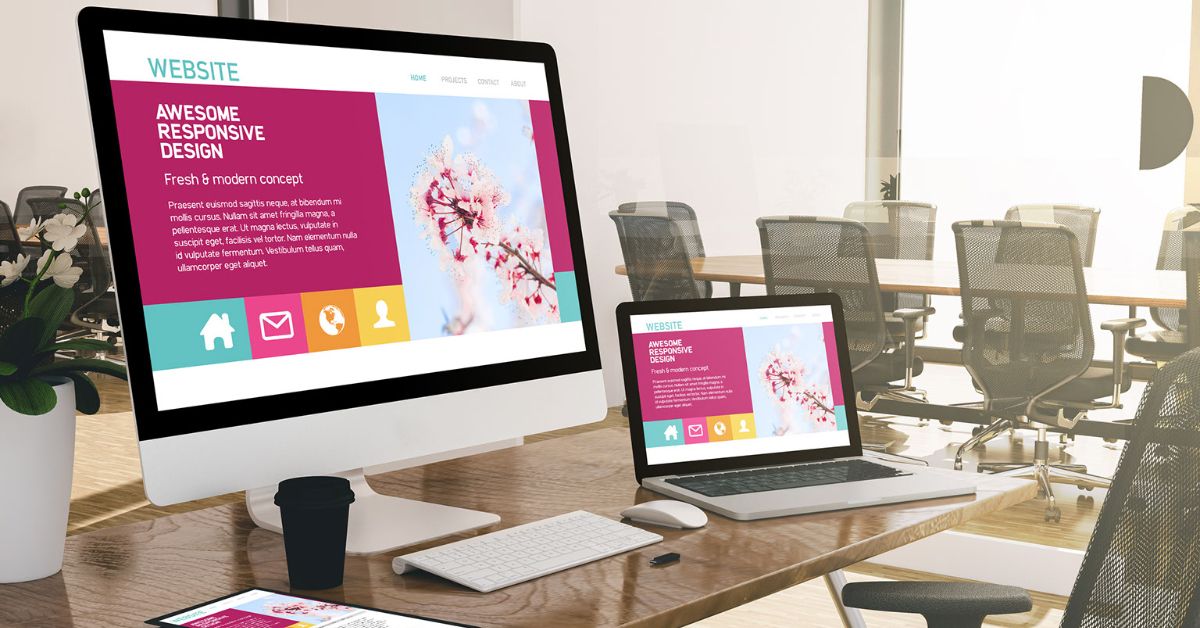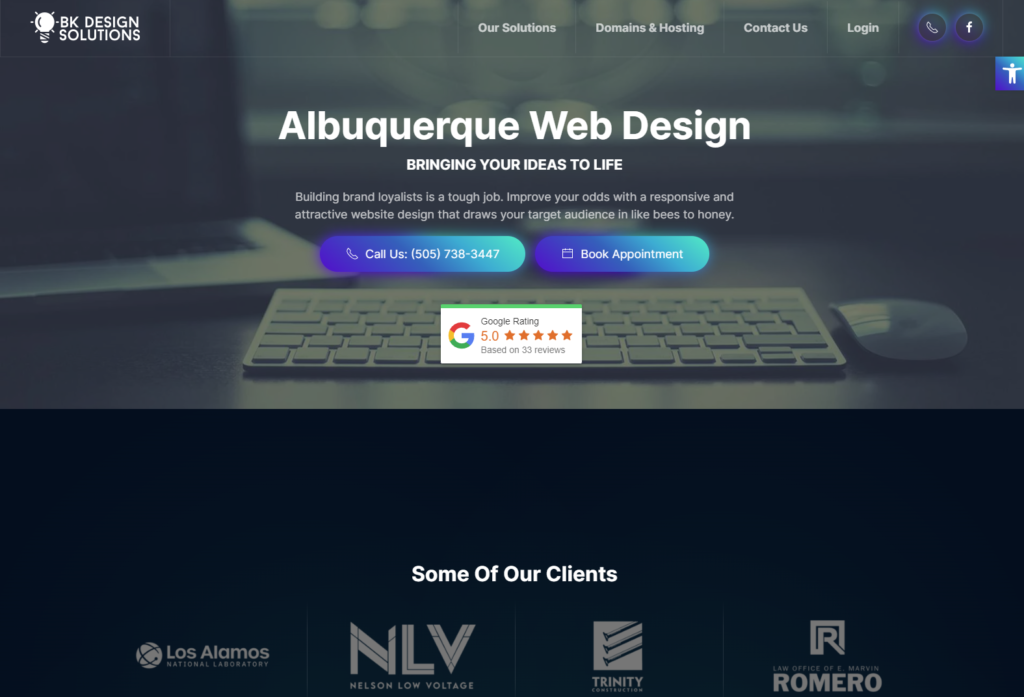Big Guide to Web Design in Albuquerque

Businesses trying to compete without the advantages of a high-quality website optimized for local or traditional SEO are doomed to failure. In today’s digital age, most consumers rely on their mobile devices to quickly gain access to the products and services they need.
In this big guide to web design in Albuquerque, we discuss why having a well-designed website is essential for your success.
Whether you’re starting from scratch or redesigning your website to improve its performance, you can use this blog to learn:
- What are the basics of web design?
- How do you find the right web design agency in Albuquerque?
- What are some web design trends?
- What are best practices for web design?
- How do you build a successful web design in Albuquerque?
What are the basics of web design?
Creating a functional and intuitive website that improves the user experience involves several elements. A website should mimic your brand voice and represent your products or services in a helpful way.
Some of the critical components of an effective website design include:
- Color scheme. The colors on your website have a significant impact on its overall look and feel. Choosing a color scheme that complements your brand and creates a visually-appealing design is key. Going through the visual branding process is the best way to determine a color scheme for your website.
- Images and graphics. High-quality images and graphics make a website more engaging and visually appealing. Use original images and graphics when possible. Also, make sure your visuals are relevant to the content and optimized for web use to avoid slowing down page loading times.
- Layout and design. Arrange the elements on website pages in a clear and consistent manner to help users more easily navigate your site. Content, headers, footers, and navigation tools must be easy to find and use or you risk hurting your website’s SEO ranking.
- Navigation tools. Effective navigation helps users find the information they need quickly. A clear, intuitive navigation menu and well-organized content significantly improve the user experience.
- Responsive design. Ensure your website is optimized for viewing on a variety of devices by incorporating a responsive design. Whether your visitors come from a desktop computer or a Smartphone, your website must display well or you risk losing a potential customer.
Paying attention to these basic elements of web design in Albuquerque ensures you can use the power of digital marketing to grow your brand and increase your revenue.

How do you find the right web design agency in Albuquerque?
Finding the right web design agency in Albuquerque doesn’t have to be a difficult process when you follow a few suggested steps.
Step 1: Start the process by researching web design agencies in Albuquerque that have experience in your industry or have worked on similar projects. Using a search engine, enter queries like “web design Albuquerque” and “web design agency near me” to generate a list of results.
Step 2: Once you have a list of potential agencies, review their professional portfolios to get a feel for the kind of websites they design. Most agencies display links to their previous work on their websites. Portfolios should include a variety of projects and demonstrate the agency’s ability to create high-quality website designs.
Step 3: Check the web design agency’s reviews and testimonials from previous clients. If they have a Google My Business (GMB) profile, that’s an excellent source for customer reviews. You may also want to check their social media accounts for reviews, plus review their status with the Better Business Bureau to see if they have any unresolved complaints.
Step 4: Contact your preferred providers and ask them questions to determine if their fees align with your website budget. Make sure they present their fee structure in a clear and concise manner. Don’t be afraid to ask for a breakdown of costs so you can compare pricing with competitors fairly.
What are some web design trends?
Trends come and go. One thing that never changes is the preference for functional websites that incorporate designs that engage visitors and improve the user experience.
More than passing fads, here are some website design techniques that stand the test of time.
- Clean and minimalist layouts. More isn’t necessarily better. Flashy (and numerous) graphics slow down your website’s loading time. Embracing the “less is more” philosophy with website design is a classic approach that helps websites perform well with humans and search engines. If budget is an issue, choosing a minimalist design means you won’t have to dish out money a few years down the road for a redesigned site.
- Illustrations. Animated graphics and illustrations draw attention to important content on your website. Not only do illustrations help explain complex information, but they also encourage visitors to share them on their social media profiles and other digital accounts.
- Mobile-friendly design. Most consumers use their mobile devices to access the internet. That’s not a trend that’s going to reverse itself. Font size, navigation features, and optimized graphics are among the features of a responsive website that adapts to mobile devices. Requesting a website that’s mobile-friendly offers a significant return on investment.
- Modular design features. Logically organizing your website content helps improve the user experience. It makes information easy to locate and digest. If you run a service-based business, modular design features are an effective way to highlight each of those services.
- White space. Plain backgrounds and extra white space between content keep website visitors from becoming overstimulated by your design. It also helps web crawlers identify content and index it for search results.

What are the best practices for web design?
Web design constantly evolves. As new techniques and technology become available, web designers adopt new best practices to guide the way they serve their customers.
Some of the best practices for website design staples include:
- Focusing on user experience. One of the most important aspects of web design, user experience guidelines may change over time, but the concept behind them remains the same. Web designers must create websites that are easy to navigate, visually appealing, and provide a seamless user experience to increase engagement and conversion rates.
- Incorporating a responsive design. Websites that are easy to navigate are designed to respond to the viewing device. Whether someone logs in from their desktop computer or their mobile phone, website design best practices recommend a seamless experience that helps content display in a way that looks good and improves functionality.
- Optimizing for speed. Page load speed is a critical factor for determining user experience and search engine rankings. Web designers use techniques like caching, compression, and minification of graphics to ensure your website loads quickly.
- Prioritizing accessibility. Globally, there are an estimated 2.2 billion people with vision impairment. Professionals who provide web design in Albuquerque should comply with accessibility standards that include features like alt tags for images and proper heading structure.
How do you build a successful web design in Albuquerque?
Building a successful web design in Albuquerque requires careful planning, attention to detail, and a focus on the needs of your target audience. Working with a skilled web designer increases your chances of developing a website that checks all the boxes for improving the user experience.
Here are some tips for working with a web designer to maximize your benefits:
- Define your goals and target audience. Before you can communicate how you want your website to look, you must define your goals and audience. Businesses can rely on customer profiles to guide them to a target audience. Design depends on your goal. If converting casual visitors into returning customers is a goal, let the web designer know so they can use design techniques geared toward this purpose.
- Create a user-friendly design. A responsive design is the only way to go with your new website. You want to improve accessibility and make it intuitively adaptable to viewers using any kind of device to log onto the internet.
- Maintain your website. To keep visitors returning to your website, you need more than a functional and intuitive design. You must keep your content stocked with fresh content that adds value. Blogs, case studies, and white papers are an easy way to achieve this goal. Also, make sure you update plug-ins and other design features to ensure they continue working properly.
- Test and iterate. You’ll want to regularly test your website to identify any issues or areas for improvement. Using analytics tools can help you with this task. They track user behavior and make suggestions for website adjustments.

How to measure website success
Measuring website success requires tracking key performance indicators (KPIs) that provide insight into your website’s performance to help you determine if you’re meeting your website goals. Some of the common KPIs that indicate success include:
- Website traffic measures the number of visitors to your website. You can use analytics tools to learn where visitors spent the most time on your site and how long they engaged it.
- Engagement metrics like bounce rate, time on site, and pages per session tell you how visitors interact with your site (and for how long). Once you know which content attracts the most visitors, you can create more of it to continue adding value.
- Conversion rates reveal the number of visitors to your website who take a desired action (buying a product, booking a demo, subscribing to a newsletter). Tracking conversions helps you identify areas for improvement.
- Search engine ranking provides insight into how well your website is optimized for search engines. Higher rankings drive more traffic and improve visibility.
- Revenue generated through your website is a direct measure of its success. Tracking this metric helps ensure your website is providing a solid return on the investment.
Work with a trusted web designer in Albuquerque
Working with a trusted web designer in Albuquerque ensures your website meets all goals and expectations. Skilled designers create a website that is intuitive and responsive and clearly organizes all relevant information for your visitors.
Reach out to BK Design Solutions today to discover why we’re one of Albuquerque’s most recommended web design agencies.
albuquerque web design, Albuquerque website developers, web design in Albuquerque